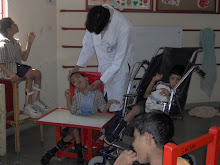Dr Sharat Chandra Pani
A noisy crowded market, the sound of blaring horns, vegetable vendors and the thick fumes from buses, cars and two wheelers. On the first floor of an old building stands a dental clinic. To a stranger this may seem like the beginning of a rustic travelogue; except that it holds good for any Indian city or town. The past ten years have seen the true emergence of dentistry in India. As the number of dentists has grown so have the number of clinics. Yet most of these clinics are located in buildings which; by all western standards; fail any test of accessibility. Narrow crowded lanes, narrower corridors, steep staircases, narrow doors... the list is endless. And yet are they truly inaccessible? The crowds in the waiting areas would disagree. Apply this scenario to any city or town you like; the clinic with the greatest inflow of patients will most probably be located in a location similar to the one described above. Does this mean that the concept of accessibility is flawed? Or that we have gotten used to the idea of poor infrastructure? Before we answer any of those questions we might do well to take another look at how we define accessibility.
Accessibility: Physical or Economical?
If we choose to define accessibility in its conventional sense, as physical access to dental care, then we would have to agree that dental clinics in India (most of them anyway) would fail even the most lenient evaluation of access. However if you were to look at access more holistically, then you would find that the clinics described above are surprisingly accessible. Consider the case of a practice located in a small town, catering largely to patients from nearby villages. A clinic in the crowded market next to the bus stand is much easier to access(and also cheaper) than a clinic in relatively calm surroundings that require the patient to travel a little further. We should perhaps be forgiven for assuming that a patient who has travelled maybe 10 to 20 Km over bad roads, in a bus that has no special accessibility features would not mind climbing 10 steps up a narrow corridor. If accessibility features require the dentist to move out of the crowded market then the very fact that his/her patients have to travel the extra distance negates any benefit the features offer. If the dentist can save on his operating costs by renting space on the first floor, then surely the effort the patient has to make to climb that extra flight of stairs is offset by the resulting reduction in the cost of care. And to talk about parking space in a country where less than 1% of the population drives a car is surely hypocritical. So should we sit back and accept things the way they are? Absolutely not.
Incorporating Access
“Sometimes we stare so long at a door that is closing that we see too late the one that is open.”
-Alexander Graham Bell
If the process of access is considered once you have built a building or set up a clinic then it is often too expensive to implement. But if you consider access at the time of construction then the costs are not significantly higher. Putting in a wider door, or setting up the chair and other fittings so as to allow the movement of a wheelchair is not that difficult. Even once the clinic is set up access can be greatly improved by considering these few simple and inexpensive points;
- Grab Rails: These are small metal railings, similar to a towel stand you put up in the bathroom. When put up along the walls of the clinic or adjacent to the chair they allow the patient to get a firm grip to move him/herself from the wheelchair onto the dental chair.
- Reduce clutter: Simple as this may sound, moving a bulky cupboard to a corner or rearranging a chest of drawers can give you much greater room for the placement of a wheel chair.
- Place Kick Boards on your doors: A kick board is a piece of metal that is nailed to the lower part of the door. The kick board allows a person in a wheelchair to kick the door open without damaging the door.
- A tap with a single twist and large handle: These taps are easier to use than the turn taps, and can be operated even by people with poor hand strength and/or coordination
The steps mentioned here are just a few simple inexpensive methods to make your clinic more accessible. We at DCSN recognize that accessibility is a complex problem that requires improvement not only on our part but also in the way our society views the needs of differently abled individuals. However the steps mentioned above can greatly help a person without any real increase in cost to either the dentist or the patient. I would be wise to remember that more than an open door, access requires an open mind.







No comments:
Post a Comment